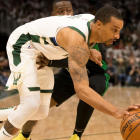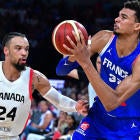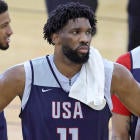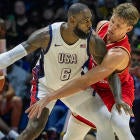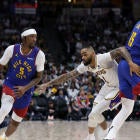Coaches love to talk about attention to detail, especially this time of year. A well-timed cut can lead to a wide-open 3 that starts a run that breaks open a game that changes the complexion of a series. In the same way, a relatively minor roster move can have significant consequences in the playoffs. At his end-of-season press conference on Monday, Oklahoma City Thunder general manager Sam Presti lamented that the team couldn't withstand the loss of guard Alex Abrines, who left the team due to a personal matter and was waived in February. Presti said that there were not any suitable replacements on the buyout market after Wesley Matthews signed with the Indiana Pacers, so Oklahoma City was short on shooting and wing depth.
A more positive example: the Milwaukee Bucks' acquisition of George Hill. In early December, they traded a 2021 first-round pick and two second-round picks along with guard Matthew Dellavedova and center John Henson for the 32-year-old Hill and center Jason Smith. The transaction wasn't celebrated nearly as much as their deadline-day deal for Nikola Mirotic was, and it didn't change the team's identity like the hiring of coach Mike Budenholzer and signing of Brook Lopez did. The praise that Milwaukee received was as much about the financial flexibility it had gained by dumping Dellavedova and Henson as it was about what it meant for its rotation. In the Bucks' most important game of the season, though, Hill's presence was crucial.
The box score will tell you that Hill was plus-27 in 25 minutes and scored 10 points on 3-for-6 shooting in Milwaukee's 123-102 win in Game 2 of its second-round series against the Boston Celtics on Tuesday. Any analysis of how the team with the league's best record avoided falling behind 2-0, though, has to start with Budenholzer's big defensive adjustment. The Bucks had the most stingy defense in the regular season, but were torched in the opener. They responded by switching more liberally than ever before. On one successful possession, Hill switched from Kyrie Irving to Gordon Hayward to Al Horford:
"In Game 1, we got beat one-on-one, screen-and-roll, Al Horford popping [and] getting wide open-looks," guard Eric Bledsoe told reporters. "When we went and looked back at the film, we just thought that was the right thing. Coach Bud did a great job, his staff did a great job of making adjustments."
Irving missed 14 of his 18 shots and finished with just nine points in 31 minutes, the first time he'd failed to reach double digits since a late-February loss in Toronto. For the 18 minutes that Hill was on the floor with Irving, his job was to apply pressure without fouling, deny him the ball, stay in front of him and contest his jump shots. Hill is suited for this because of his length and anticipation. No one can consistently shut down Irving one-on-one, but Hill can at least make him work. His most impressive individual defense might have come on this play, which ended with Irving scoring two points:
I will never forget Hill's performance in the seven-game slugfest between the Pacers and Raptors in 2016. In that first-round series, he hounded Kyle Lowry to the point where I wondered if the All-Star could even walk down the street without the sensation that there was a man with a 6-foot-9 wingspan trailing him. Hill might not be the stopper that he was a few years ago, but that wingspan makes him a perfect fit for the Bucks' new game plan against Boston. When Irving isn't on the court, Hill starts defensive possessions matched up with Hayward or Jayson Tatum. Budenholzer seemed comfortable with him switching onto Marcus Morris, too. This versatility helps Milwaukee's transition defense, and it is why Hill is, in the parlance of Draymond Green, a 16-game player.
If Milwaukee is going to take control of the series, it will need Giannis Antetokounmpo, Khris Middleton and Bledsoe to continue to score the way they did in Game 2. The Celtics will be prepared for the switching from now on, and it's unlikely that Irving will shoot that poorly again. The Bucks' best hope, though, is that the defensive habits they have been building since October will carry them to the conference finals, even if their strategy is different. The most encouraging thing I saw from Milwaukee on Tuesday was this swarming defense at the end of the third quarter, up by 25 points:
At the time, that looked like chaos. The Bucks were flying around, making it seem like they had six players on the court. Watch it again and you'll see Hill switch onto Hayward, provide help on a Rozier drive and force a Tatum turnover. It's the little things.









